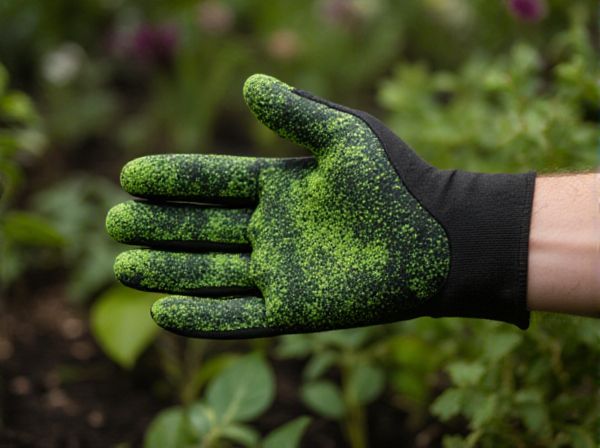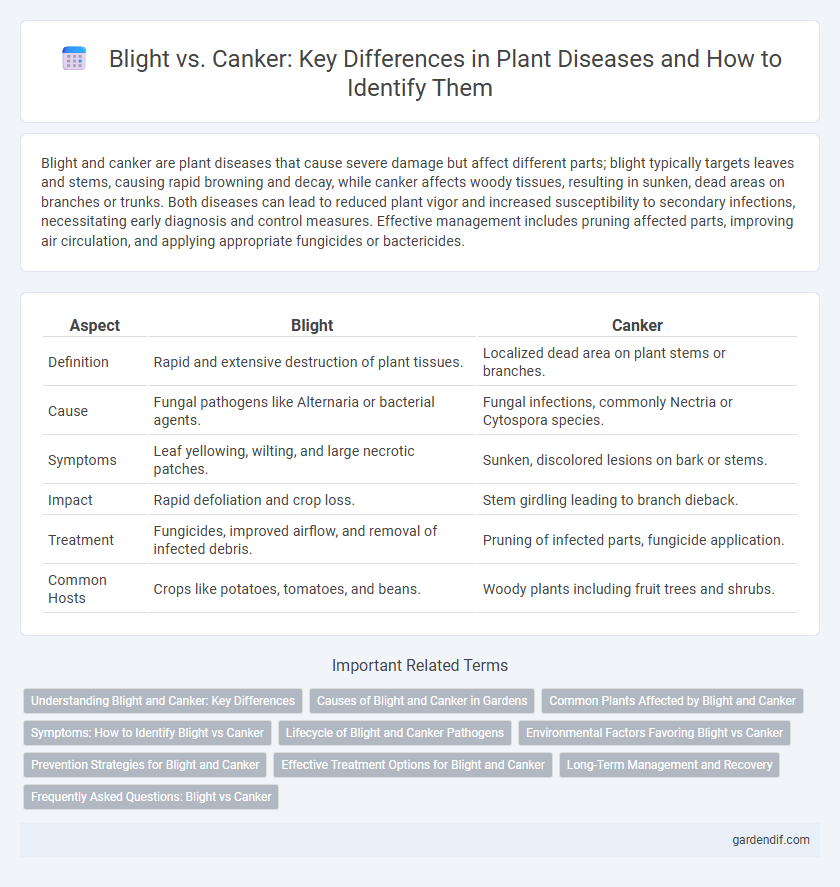
Blight vs Canker Illustration
Blight and canker are plant diseases that cause severe damage but affect different parts; blight typically targets leaves and stems, causing rapid browning and decay, while canker affects woody tissues, resulting in sunken, dead areas on branches or trunks. Both diseases can lead to reduced plant vigor and increased susceptibility to secondary infections, necessitating early diagnosis and control measures. Effective management includes pruning affected parts, improving air circulation, and applying appropriate fungicides or bactericides.
Table of Comparison
| Aspect | Blight | Canker |
|---|---|---|
| Definition | Rapid and extensive destruction of plant tissues. | Localized dead area on plant stems or branches. |
| Cause | Fungal pathogens like Alternaria or bacterial agents. | Fungal infections, commonly Nectria or Cytospora species. |
| Symptoms | Leaf yellowing, wilting, and large necrotic patches. | Sunken, discolored lesions on bark or stems. |
| Impact | Rapid defoliation and crop loss. | Stem girdling leading to branch dieback. |
| Treatment | Fungicides, improved airflow, and removal of infected debris. | Pruning of infected parts, fungicide application. |
| Common Hosts | Crops like potatoes, tomatoes, and beans. | Woody plants including fruit trees and shrubs. |
Understanding Blight and Canker: Key Differences
Blight causes rapid and severe damage to leaves, stems, or flowers, leading to widespread tissue death often triggered by fungal or bacterial infections. Canker manifests as localized sunken lesions on stems or branches, disrupting nutrient flow and weakening plant structure through fungal or bacterial pathogens. Recognizing that blight affects larger plant areas while canker targets specific woody tissues aids in effective disease diagnosis and management strategies.
Causes of Blight and Canker in Gardens
Blight in gardens is primarily caused by fungal pathogens such as Phytophthora, Alternaria, and Botrytis, which thrive in moist conditions and lead to rapid decay of leaves, stems, and fruits. Canker results from bacterial or fungal infections like Nectria, Cytospora, and Cryptodiaporthe that invade tree bark through wounds or stressed tissue, causing lesions and girdling. Environmental stressors, including excessive rainfall for blight and physical injury or drought for canker, significantly increase susceptibility in plants.
Common Plants Affected by Blight and Canker
Blight commonly affects a wide range of plants including tomatoes, potatoes, and various cereal crops, causing rapid browning and death of leaves and stems. Canker is frequently found on woody plants such as fruit trees like apples, cherries, and citrus, leading to sunken, dead areas on branches or trunks. Both diseases significantly impact agricultural productivity and require targeted management strategies to protect vulnerable crops.
Symptoms: How to Identify Blight vs Canker
Blight symptoms include rapid discoloration and wilting of leaves, often starting at the tips or edges and spreading quickly, leading to tissue death and browning. Canker is characterized by sunken, discolored lesions on stems or branches, causing bark cracking and oozing sap, which may girdle and kill affected plant parts. Identifying blight involves observing widespread foliar damage, whereas canker identification requires close examination of woody tissues for localized decay and deformities.
Lifecycle of Blight and Canker Pathogens
Blight pathogens often have a rapid lifecycle, producing spores that spread quickly under humid conditions, leading to widespread leaf and stem necrosis within days. Canker pathogens, typically fungi or bacteria, develop more slowly by invading woody tissues and causing localized lesions that expand over weeks or months, eventually disrupting nutrient flow. Both diseases rely on environmental factors such as moisture and temperature to activate their reproductive stages, influencing infection severity and spread.
Environmental Factors Favoring Blight vs Canker
Blight thrives in warm, humid environments with frequent rainfall, which create ideal conditions for rapid fungal growth and spore dispersal. Canker development is favored by wounds on woody plants combined with cooler, wet climates that allow pathogens to infiltrate and decay the bark tissue. Both diseases are influenced by moisture levels, but blight more aggressively exploits high humidity, while canker is typically associated with damage and prolonged wet periods.
Prevention Strategies for Blight and Canker
Prevention strategies for blight emphasize proper plant spacing to improve air circulation and reduce humidity, along with timely application of fungicides to inhibit fungal growth. Canker prevention focuses on maintaining tree vigor through appropriate pruning techniques to remove infected branches and ensuring wound protection with pruning sealants to prevent pathogen entry. Both diseases benefit from sanitation practices such as removing and destroying infected plant material to minimize disease spread.
Effective Treatment Options for Blight and Canker
Effective treatment options for blight primarily involve the application of systemic fungicides such as chlorothalonil and copper-based sprays to halt the spread of fungal spores and protect new growth. For canker diseases, pruning infected branches during dry weather combined with the use of protective wound paints containing fungicides like thiophanate-methyl significantly reduces pathogen colonization and promotes healing. Implementing proper sanitation measures and selecting resistant plant varieties enhances control success for both blight and canker infections.
Long-Term Management and Recovery
Effective long-term management of blight involves consistent application of fungicides, resistant crop varieties, and crop rotation to prevent re-infection and reduce pathogen persistence in the soil. In contrast, canker requires thorough pruning of infected branches, sanitation practices to remove infected material, and sometimes chemical treatments to protect healthy tissue and promote tree recovery. Both diseases benefit from ongoing monitoring and environmental adjustments to improve plant resilience and minimize future outbreaks.
Frequently Asked Questions: Blight vs Canker
Blight and canker are common plant diseases that cause tissue damage, but blight typically results in rapid browning and death of leaves, stems, or flowers, while canker manifests as sunken, dead areas on branches or trunks. Blight is usually caused by fungal or bacterial infections affecting above-ground plant parts, whereas canker primarily affects woody tissues and can lead to structural weakening. Managing both diseases involves pruning affected areas and applying appropriate fungicides or bactericides tailored to the specific pathogen.
Blight vs Canker Infographic

 gardendif.com
gardendif.com